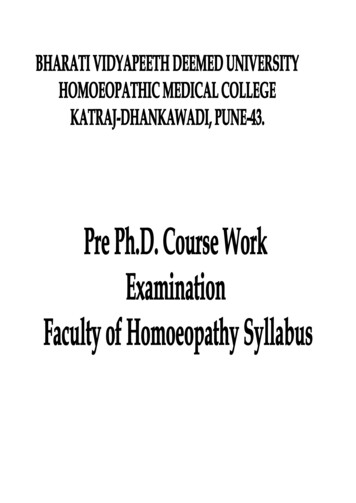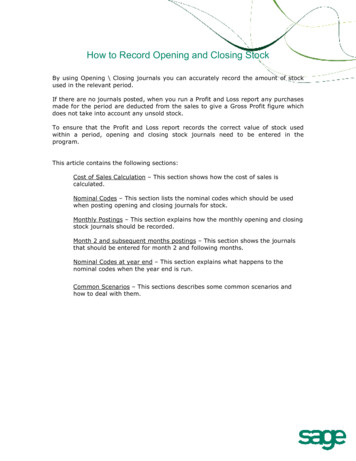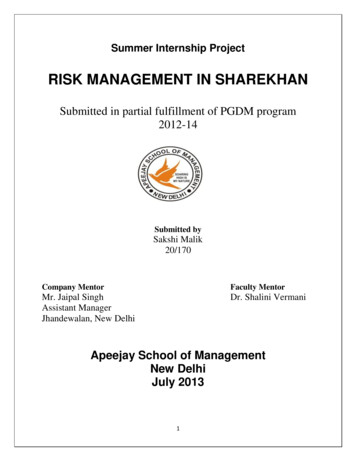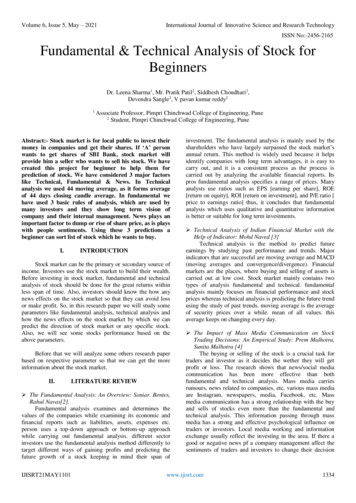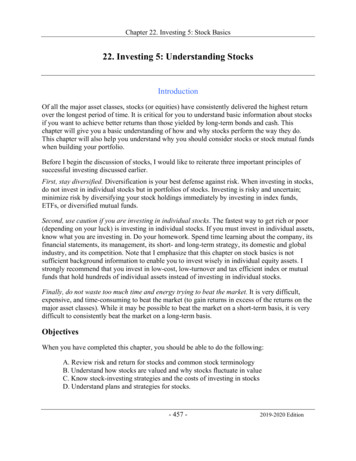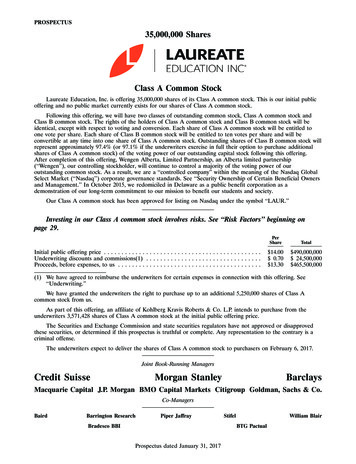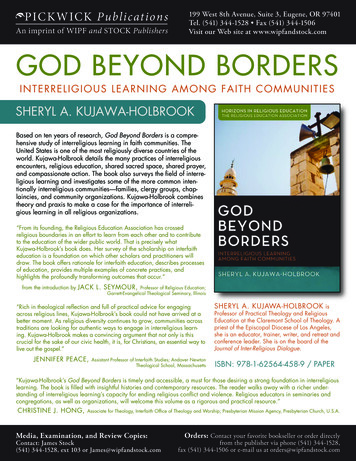
Transcription
PICKWICK PublicationsAn imprint of WIPF and STOCK Publishers199 West 8th Avenue, Suite 3, Eugene, OR 97401Tel. (541) 344-1528 Fax (541) 344-1506Visit our Web site at www.wipfandstock.comGOD BEYOND BORDERSIN TE R R E L I GI O US LEARNI NG A M ONG F A ITH COMMUN I T I E SSHERYL A. KUJAWA-HOLBROOKBased on ten years of research, God Beyond Borders is a comprehensive study of interreligious learning in faith communities. TheUnited States is one of the most religiously diverse countries of theworld. Kujawa-Holbrook details the many practices of interreligiousencounters, religious education, shared sacred space, shared prayer,and compassionate action. The book also surveys the field of interreligious learning and investigates some of the more common intentionally interreligious communities—families, clergy groups, chaplaincies, and community organizations. Kujawa-Holbrook combinestheory and praxis to make a case for the importance of interreligious learning in all religious organizations.“From its founding, the Religious Education Association has crossedreligious boundaries in an effort to learn from each other and to contributeto the education of the wider public world. That is precisely whatKujawa-Holbrook’s book does. Her survey of the scholarship on interfaitheducation is a foundation on which other scholars and practitioners willdraw. The book offers rationale for interfaith education, describes processesof education, provides multiple examples of concrete practices, andhighlights the profoundly transforming outcomes that occur.”from the introduction byJACK L. SEYMOUR,Professor of Religious Education;Garrett-Evangelical Theological Seminary, Illinois“Rich in theological reflection and full of practical advice for engagingacross religious lines, Kujawa-Holbrook’s book could not have arrived at abetter moment. As religious diversity continues to grow, communities acrosstraditions are looking for authentic ways to engage in interreligious learning. Kujawa-Holbrook makes a convincing argument that not only is thiscrucial for the sake of our civic health, it is, for Christians, an essential way tolive out the gospel.”JENNIFER PEACE,Assistant Professor of Interfaith Studies; Andover NewtonTheological School, MassachusettsSHERYL A. KUJAWA-HOLBROOK isProfessor of Practical Theology and ReligiousEducation at the Claremont School of Theology. Apriest of the Episcopal Diocese of Los Angeles,she is an educator, trainer, writer, and retreat andconference leader. She is on the board of theJournal of Inter-Religious Dialogue.ISBN: 978-1-62564-458-9 / PAPER“Kujawa-Holbrook’s God Beyond Borders is timely and accessible, a must for those desiring a strong foundation in interreligiouslearning. The book is filled with insightful histories and contemporary resources. The reader walks away with a richer understanding of interreligious learning’s capacity for ending religious conflict and violence. Religious educators in seminaries andcongregations, as well as organizations, will welcome this volume as a rigorous and practical resource.”CHRISTINE J. HONG,Associate for Theology, Interfaith Office of Theology and Worship; Presbyterian Mission Agency, Presbyterian Church, U.S.A.Media, Examination, and Review Copies:Contact: James Stock(541) 344-1528, ext 103 or James@wipfandstock.comOrders: Contact your favorite bookseller or order directlyfrom the publisher via phone (541) 344-1528,fax (541) 344-1506 or e-mail us at orders@wipfandstock.com
God Beyond Borders
Horizons in Religious Education is a book series sponsored by the Religious Education Association: An Association of Professors, Practitioners and Researchers in Religious Education. It was established to promote new scholarship and exploration in theacademic field of Religious Education. The series will include both seasoned educatorsand newer scholars and practitioners just establishing their academic writing careers.Books in this series reflect religious and cultural diversity, educational practice,living faith, and the common good of all people. They are chosen on the basis of theircontributions to the vitality of religious education around the globe. Writers in thisseries hold deep commitments to their own faith traditions, yet their work sets forthclaims that might also serve other religious communities, strengthen academic insight,and connect the pedagogies of religious education to the best scholarship of numerouscognate fields.The posture of the Religious Education Association has always been ecumenicaland multi-religious, attuned to global contexts, and committed to affecting public life.These values are grounded in the very institutions, congregations, and communities thattransmit religious faith. The association draws upon the interdisciplinary richness of religious education connecting theological, spiritual, religious, social science and culturalresearch and wisdom. Horizons of Religious Education aims to heighten understandingand appreciation of the depth of scholarship resident within the discipline of religiouseducation, as well as the ways it impacts our common life on a fragile world. Withouta doubt, we are inspired by the wonder of teaching and the awe that must be taught.Jack L. Seymour (chair), Garrett-Evangelical Theological SeminaryDean G. Blevins, Nazarene Theological SeminaryDori Grinenko Baker, The Fund for Theological Education & Sweet Briar CollegeRandy Litchfield, Methodist Theological School in OhioSondra H. Matthaei, Saint Paul School of TheologySiebren Miedema, Vrije Universiteit AmsterdamHosffman Ospino, Boston CollegeMai-Anh Le Tran, Eden Theological SeminaryAnne Streaty Wimberly, Interdenominational Theological Seminary
God Beyond BordersInterreligious Learning Among Faith CommunitiesSheryl A. Kujawa-Holbrook
God Beyond BordersInterreligious Learning Among Faith CommunitiesHorizons in Religious Education 1Copyright 2014 Sheryl A. Kujawa-Holbrook. All rights reserved. Except for briefquotations in critical publications or reviews, no part of this book may be reproduced in any manner without prior written permission from the publisher. Write:Permissions, Wipf and Stock Publishers, 199 W. 8th Ave., Suite 3, Eugene, OR 97401.Pickwick PublicationsAn Imprint of Wipf and Stock Publishers199 W. 8th Ave., Suite 3Eugene, OR 97401www.wipfandstock.comisbn 13: 978–71-62564–458-9Cataloguing-in-Publication data:Kujawa-Holbrook, Sheryl A.God beyond borders : interreligious learning among faith communities / SherylA. Kujawa-Holbrook.xlii 174 pp. ; 23 cm. Includes bibliographical references.Horizons in Religious Education 1isbn 13: 978–71-62564–458-91. Religious Education. I. Series. II. Title.BL65 F2 K85 2014Manufactured in the U.S.A.
To my mentor, friend, colleagueEdward W. Rodman
God beyond borderswe bless you for strange placesand different dreamsfor the demands and diversityof a wider worldfor the distancethat lets us look back and re-evaluatefor new groundwhere the broken stems can take root,grow and blossom.We bless youfor the friendship of strangersthe richness of other culturesand the painful gift of freedomBlessed are you,God beyond borders.But if we have overlookedthe exiles in our midstheightened their exclusionby our indifferencegiven our permissionfor a climate of fearand tolerated a culture of violenceHave mercy on us,God who takes side with justice,confront our prejudicestretch our narrownesssift out our laws and our liveswith the penetrating insightof your spirituntil generosity is our only measure.Amen11. Kathy Galloway, Maker’s Blessing (Glasgow: Wild Goose Publications, 2000). Usedwith Permission.
ContentsSeries Foreword viiiPreface by Eboo Patel ixAcknowledgments xiiiIntroduction xvii1 Ways of Understanding Interreligious Learning 12 The Transformative Power of Interreligious Encounter 303 Practices of Interreligious Learning 524 Sharing Sacred Spaces 765 Compassionate Action as Interreligious Learning 1026 Initiating Intentional Interreligious LearningCommunities 1247 Interreligious Learning and the Future 146References 159Appendix: An Interreligious Transformation Continuum forChristian Congregations and Organizations 167About the Author 171
Series ForewordThe editorial board of Horizons in Religious Education is delighted toselect God Beyond Borders: Interreligious Learning Among Faith Communities by Sheryl A. Kujawa-Holbrook as the first book in the series. Indeed thisbook leads us towards the horizons of the field. What could be more timelyin our world of rapid technology, almost instant communication, shiftingpolitical boundaries and alliances, and conflict, some of which results fromreligious communities? Her attention to how we can come to know and understand each other contributes hope to our world. Dr. Kujawa-Holbrookteaches in an interfaith environment and has comprehensively researchedefforts across the continent to engage in interfaith learning and education.From its founding the Religious Education Association has crossedreligious boundaries in an effort to learn from each other and to contribute to the education of the wider public world. That is precisely what Dr.Kujawa-Holbrook’s book does. Her survey of the scholarship on interfaitheducation is a foundation on which other scholars and practitioners willdraw. The book offers rationale for interfaith education, describes processes of education, provides multiple examples of concrete practices, andhighlights the profoundly transforming outcomes that occur. Her workbuilds on and extends the mission of the Religious Education Association.We are honored to publish it. We encourage you to draw deeply of thisbook and further extend the horizons of our work for the flourishing of theworld we share.
Prefaceby Eboo PatelSheryl Kujawa-Holbrook’s important book on congregations andinterfaith cooperation reminds me of a crucial moment in American history. When, as a seminary student, Martin Luther King Jr. was introducedto the satyagraha (“love-force”) philosophy of the Indian Hindu leaderMahatma Gandhi, King did not reject it because it came from a differentreligion. Instead, he sought to find resonances between Gandhi’s Hinduismand his own interpretation of Christianity. Indeed, it was Gandhi’s movement in India that provided King with a twentieth-century version of whatJesus would do. King patterned nearly all the strategy and tactics of thecivil rights movement—from boycotts to marches to readily accepting jailtime—after Gandhi’s leadership in India. King called Gandhi “the first person in history to lift the love ethic of Jesus above mere interaction betweenindividuals to a powerful and effective social force.”Following Gandhi was King’s first step on a long journey of learning about the shared social justice values across the world’s religions, andpartnering with faith leaders of all backgrounds in the struggle for civilrights. In 1959, more than a decade after the Mahatma’s death, King traveled to India to meet with people continuing the work Gandhi had started.He was surprised and inspired that this movement included Indians of allfaith backgrounds working for equality and harmony, discovering in theirown traditions of Islam, Buddhism, Jainism, Sikhism and Humanism thesame inspiration for love and peace that Gandhi found in Hinduism andKing in Christianity.King’s experience with religious diversity in India shaped the rest ofhis life. He readily formed a friendship with the Rabbi Abraham Joshuaix
PrefaceHeschel, finding a common bond in their love of the Hebrew prophets.The two walked arm-in-arm in the famous civil rights march from Selmato Montgomery. In his famous sermon “A Time to Break Silence,” Kingwas unequivocal about his Christian commitment and at the same timesummarized his view of the powerful commonality across all faiths: “ThisHindu-Muslim-Christian-Jewish-Buddhist belief about ultimate reality” isthat the force of love is “the supreme unifying principle of life.”One of the great gifts of Sheryl’s book is that it shines a light on thispath that King walked, showing all of us involved with religious congregations how we can be interfaith leaders. There are too many out there whowould say off-handedly, “The reason religions fight is because they’ve alwaysfought.” But when we tell the history of America as it speaks to interfaithcooperation, we know that’s just not true. Rev. King and Rabbi Heschel aretwo examples of interfaith leaders—people who have the knowledge andskills to stop that fiction with knowledge, build relationships between theircommunities, and work together to better our common world.What is especially important to emphasize about each of these leadersis that they had what I call a theology of interfaith cooperation, or knowledgeof one’s religion’s inspiration to cooperate with others. At the organization Ifounded, Interfaith Youth Core, we believe that religion in the 21st centurycan be a bubble of isolation; a barrier of division; a bomb of destruction;or a bridge of cooperation. Faith communities make these choices, in part,guided by their theology of engaging the religious other. If you ask the people who are building barriers, “What in your faith inspires you to separateyourself from people of other faiths?” they will cite you chapter and verse.They know the scripture, they know the heroes, and they know the stories.So, if somebody asked you and me, “What is your theology of interfaithcooperation? What in the Christian tradition, in the Jewish faith, in Islamiccivilization inspires you to build interfaith cooperation?” what would youand I say to that? This is an increasingly critical question to answer, and itought to be answered everywhere from kindergarten religious educationclasses in churches, synagogues and mosques all the way to seminary. Thisbook is an important guide on that journey.Here is a small snapshot for what a theology of interfaith cooperationmight look like for me as a Muslim. I hope as you read this, you’ll be thinking about the scripture and stories in your own faith that would make upyour theology of interfaith cooperation. In the Holy Qur’an God tells theProphet Muhammad that he was sent to be nothing but a special mercyx
Prefaceupon all the worlds.” The Prophet is described as, a special mercy upon allthe worlds—not a kindness for Muslims alone, not an enrichment for theArabs of the seventh century, but a mercy upon all the worlds. That to me isa vision of interfaith cooperation that transcends the lines of tribe.Here is another story from Islam along these lines. There is a story of agroup of Christians who came to visit the Prophet in the city of Medina, andthey argued with the Prophet about the nature of Jesus, and about theology.When it came time for the Christians to pray, they asked the Prophet if hewould give them leave, so they could exit and could give their prayers outside the city of the Prophet. Muhammad said, “Why would you leave? Offeryour prayers in my mosque.” And the Christians said, “But we’ve spent thelast several hours arguing theology. We were afraid you wouldn’t even let usleave.” The Prophet said, “Just because we differ on theology doesn’t meanI don’t offer you hospitality. It doesn’t mean I don’t seek cooperation withyou. It doesn’t mean I don’t see you with human dignity.”These are the building blocks of my Muslim theology of interfaith cooperation. The stories go on and on, and the scripture is seemingly endless.Just like in Judaism and Christianity, just like in Buddhism and Hinduism.But it is not enough to individually know these stories. We must share themwith our congregations and colleges, and not only be inspired to love oneanother but to act on those theologies and build interfaith cooperation inour communities.In other words, we must take upon ourselves the responsibility ofbridge-building.xi
1Ways of UnderstandingInterreligious LearningI sense in some of the most strident Christian communities littleawareness of this new religious America, the one Christians now sharewith Muslims, Buddhists, and Zoroastrians. They display a confident,unselfconscious assumption that religion basically means Christianity,with traditional space made for Jews. But make no mistake: in the pastthirty years, as Christianity has become more publicly vocal, somethingelse of enormous importance has happened. The United States hasbecome the most religiously diverse nation on earth.Diana Eck, A New Religious America (Eck 2001, 4)Interreligious learning is now a growing interdisciplinary field ofscholarly inquiry and pedagogical practice. The purpose of this chapteris to examine the ways of understanding interreligious learning, its development as a field of inquiry, and the range of approaches found withinChristian faith communities and religious organizations. Integral to interreligious learning is the importance of personal narratives, both the learning and the unlearning of stories of religious pluralism, and the histories offaith communities from an interreligious perspective. The importance ofreligious literacy as a critical component of interreligious learning is discussed, as are the methodological tools which shape effective interreligious1
God Beyond Borderslearning. Finally, this chapter will look at the Interreligious TransformationContinuum across Christian congregations and religious organizations, theimplications of these varying approaches for interreligious learning, as wellas suggestions for supporting future growth.What Is Interreligious Learning?Interreligious learning is an emerging discipline with the aim to help allparticipants to acquire the knowledge, attitudes and skills needed to interact, understand, and communicate with persons from diverse religioustraditions; to function effectively in the midst of religious pluralism; andto create pluralistic democratic communities that work for the commongood. Interreligious learning is an interdisciplinary field that draws content, conceptual frameworks, processes and theories from religious education, religious studies, multicultural education, racial and ethnic studies,women’s studies, youth studies, sociology, peace and reconciliation studies,congregational studies, and public policy studies. It also applies, challenges,and interprets insights from these fields to pedagogy and curriculum development in diverse educational settings, including faith communities,schools, and organizations.Interreligious learning begins with stories and identifying sharedvalues. As a process it should be grounded in the spiritual journeys of individuals and groups, and connected to a vision for humankind to love oneanother as neighbors. Interreligious learning, like other transformationalexperiences, will best occur within groups. While this does not excludethe need for individual interreligious learning and reflection, these experiences alone do not replace the importance of forming relationships acrossreligious traditions within the process. Learners and their life histories andexperiences should be at the center of interreligious teaching and learning. Learning which occurs in contexts that are familiar to people, that addresses multiple learning styles, and encourages critical thinking, shapestransformative interreligious encounters.Interreligious learning values cultural differences and religiouspluralism in learners, their communities, and in religious leaders andteachers. It requires cultural competency that understands the complexities of religious, cultural, racial, linguistic, regional, and national differences, as well as differences due to gender, sexual identities, economicstatus, immigration status, and age. Interreligious learning challenges2
Ways of Understanding Interreligious Learningdiscrimination and addresses intolerance and oppression. Throughoutthe learning process, sensitivity to feelings, conflicts, prejudices, generalizations, and other impediments to community building across differences need to be acknowledged and addressed openly. Power analysis andopenness to structural equality and the redistribution of power amongdiverse groups are key values and skills in working for the common good.Shared leadership and facilitation is ideal in interreligious encounters,as is the need for democratic space and the expectation that learners areactively engaged in their own learning.Religious literacy is integral to interreligious learning, includingknowledge and understanding of one’s own religious tradition, as well asother religious traditions. Interreligious learning builds on and expands theformation of positive and critical religious identities for all ages. It assumesthat adherents are the experts of their own religious experience, and haveperspectives and information which is of value to others. Interreligiouslearning strives to first recognize the good in one’s own religious tradition and that of others, at the same time acknowledging that all religioustraditions also have limitations as human interpretations of the Divine. Ininterreligious learning, dialogue is as much about listening as it is aboutspeaking. Learners must be religiously literate and capable of forming relationships with individuals, families and communities in order to createenvironments that are supportive of multiple religious traditions, a varietyof life experiences, and democratic action.The Interreligious Dialogue TraditionThe fiftieth anniversary of the beginning of Vatican II is a reminder ofthe importance of the council in opening the door of the Roman CatholicChurch, as well as other Christian churches, to the possibilities of interreligious learning through deeper relationships with other religious traditions. Shortly after the council there was a burst of educational activity andpublications from Christian organizations and denominations interested inpursuing interreligious dialogue. Given that Christians had maintained forcenturies that there was no salvation outside of the church, and that otherreligions were seen as obstacles to mission, it is not surprising that potentialdialogue partners from other traditions were skeptical at first about Christian motivations for interreligious encounter. Indeed, given that the sloganfor the Edinburgh Missionary Conference in 1910 was “Christianization3
God Beyond Bordersof the World in this Century,” it is somewhat amazing that so many interreligious dialogues did occur in the years immediately after Vatican II. Inthese early years, a spirit of enthusiasm often carried the day, and at timesthe need to develop intentional processes and language for encounter withother religions were neglected. Some of those most engaged in interreligious dialogue in the early years were criticized for losing touch with theirown faith communities; others maintained a more conservative reaction tothe quick pace of changing attitudes toward other religious traditions. Therise in fundamentalism across religious traditions also contributed to anattitude that positive religious pluralism and lasting peace were unrealisticdreams (Evers 2012, 228–29).Despite these challenges, the field of interreligious dialogue hasexpanded over the past 60 years. It should be noted here that the term“dialogue” originated and is most often used in Christian circles, though itsometimes is adopted by members of other religious traditions. (The term“theology” is another Christian term that is used irregularly across religious traditions with a variety of meanings.) In some cases “interreligiousdialogue” is used synonymously with “interreligious learning.” In othercases, interreligious dialogue refers to specific processes designed for interreligious encounters; including dialogues between experts, interpersonaldialogues between persons of different religious traditions; and communitydialogues that are linked to social engagement and peace-building initiatives. Interest in dialogue as a methodology for interreligious encountersalso spread beyond its Roman Catholic roots. The importance of groundingChristian theology in a religiously pluralistic world is the premise behindone of the first works on interreligious dialogue to be published throughthe World Council of Churches, My Neighbor’s Faith—And Mine (1986).Based in small group learning, the purpose is “to promote an awareness ofour neighbors as people of living faiths, whose beliefs and practices shouldbecome integral elements in our theological thinking about the world andthe human community” (WCC 1986, viii).The many ways of understanding interreligious learning continuesto expand today, including the tradition of dialogue, but also including avariety of approaches and methodologies to support and enrich encounters between different religious traditions. Leonard Swidler, professor ofCatholic Thought and Interreligious Dialogue at Temple University, publishes widely and is credited by many with developing the philosophy andpedagogy of interreligious thought and practice. In particular, sources4
Ways of Understanding Interreligious Learningconcerned with interreligious dialogue often begin with Swidler’s work asa starting point. Recently Quaker teacher and editor Rebecca Kratz Mayspublished a collection of essays which update and expand Swidler’s workfrom the perspective of local communities, in Interfaith Dialogue at theGrass Roots (2008).Interest in dialogue as a primary methodology for interreligious encounters continues to be a primary theme in the literature of interreligiouslearning. One who expands the more traditional frameworks of interreligious dialogue is Bud Heckman. In his Interactive Faith, Heckman builds onthe work of the Pluralism Project at Harvard University and explores waysto balance dialogue and action in terms of learning styles, ethos, organizational structures, and mission (2008, 223). In What Do We Want The OtherTo Teach About Us? (2006), David L. Coppola of the Center for ChristianJewish Understanding of Sacred Heart University in Fairfield, Connecticut,encourages dialogue as a process which first views the other in relationshipwith God, before tackling the more abstract elements of religious belief. Hisbook is a collection of essays on Jewish-Christian-Muslim dialogue written by experienced scholars and activists and geared for religious educatorsin local synagogues, churches, and mosques. “Dialogue and education aretools for each to approach the other as people in relationship with Godfirst, and not as objects spouting abstract beliefs” (Coppola 2006, xv). Presently, Christian interreligious scholar Douglas Pratt, from the Universityof Waikato, New Zealand, and the University of Bern, Switzerland, is nowexploring the various models of interreligious dialogue gathered frominternational organizations and prevalent over the last 30–50 years withintent to expand “the praxis of dialogue” in the future (2012).Dialogical Jewish-Christian “conversations” as a means for greater interreligious understanding is the focus of the work of Joseph D. Small andGilbert S. Rosenthal’s edited volume of essays on covenantal partnership,sponsored by the Presbyterian Church (U.S.A.) and the National Councilof Synagogues. The book is offered as a model to local communities to encourage the same conversations, including controversial topics such as theState of Israel, conversion and proselytizing, and intermarriage (2010). Theuse of dialogue as a methodology is also found in literature on ChristianMuslim and Christian-Buddhist relationships. For example, Jane IdelmanSmith, professor of Islamic Studies at Harvard University and HartfordSeminary writes on the history, practice and challenges of current MuslimChristian dialogues (Smith 2007). The release in 2007, “A Common Word5
God Beyond BordersBetween Us and You,” a letter between 138 Muslim leaders worldwidesent to the leaders of major Christian denominations, and the Christianresponse, “Loving God and Neighbor Together,” affirmed both the differences between the two traditions, as well as the shared commitment tolove God and to love our neighbors. The published letters and responses,A Common Word, are one example of the emergent dialogue between thetwo traditions (Volf, Muhammad, Yarrington 2010). Paul Ingram of PacificLutheran University studies the processes of Buddhist-Christian dialogue,mapping out the conceptual, socially-engaged, and interior dimensions ofeach tradition.Interreligious Learningand Religious EducationInterreligious learning today includes the interreligious dialogue tradition,as well as additional approaches. The importance of interreligious learningwas argued by religious educators in the early twentieth century, particularly as people of faith struggled to make sense of catastrophic world wars.As early as the 1930s and 1940s, progressive religious educator AdelaideTeague Case worked with the Fellowship of Reconciliation (FOR) and other peace organizations to draft studies and curricula focused on the need tobridge cultural and religious differences around the world. From the 1940sonward, religious educator Norma H. Thompson encouraged ecumenism,and later religious pluralism, and played a key role in Jewish-Christian dialogues. Case and Thompson are only two of the many religious educatorswho practiced, taught, and wrote about the importance of religious pluralism, often before the interest of mainstream churches and denominations.No critical exploration of interreligious learning would be completedwithout mention of the ground breaking work of religious educator MaryC. Boys, now professor of practical theology at Union Theological Seminaryin New York. Through her scholarship, Boys skillfully interweaves religiouseducation with biblical studies, liturgy, and systematic theology. Boys’ worknot only emphasizes the need for Jewish-Christian dialogue, but goes a stepfurther by challenging inherent and inherited Christian supersessionism.That is
199 West 8th Avenue, Suite 3, Eugene, OR 97401 Tel. (541) 344-1528 Fax (541) 344-1506 Visit our Web site at www.wipfandstock.com PICKWICK Publications An imprint of WIPF and STOCK Publishers Orders: Contact your favorite bookseller or order directly from the publisher via phone (541) 344-1528,



